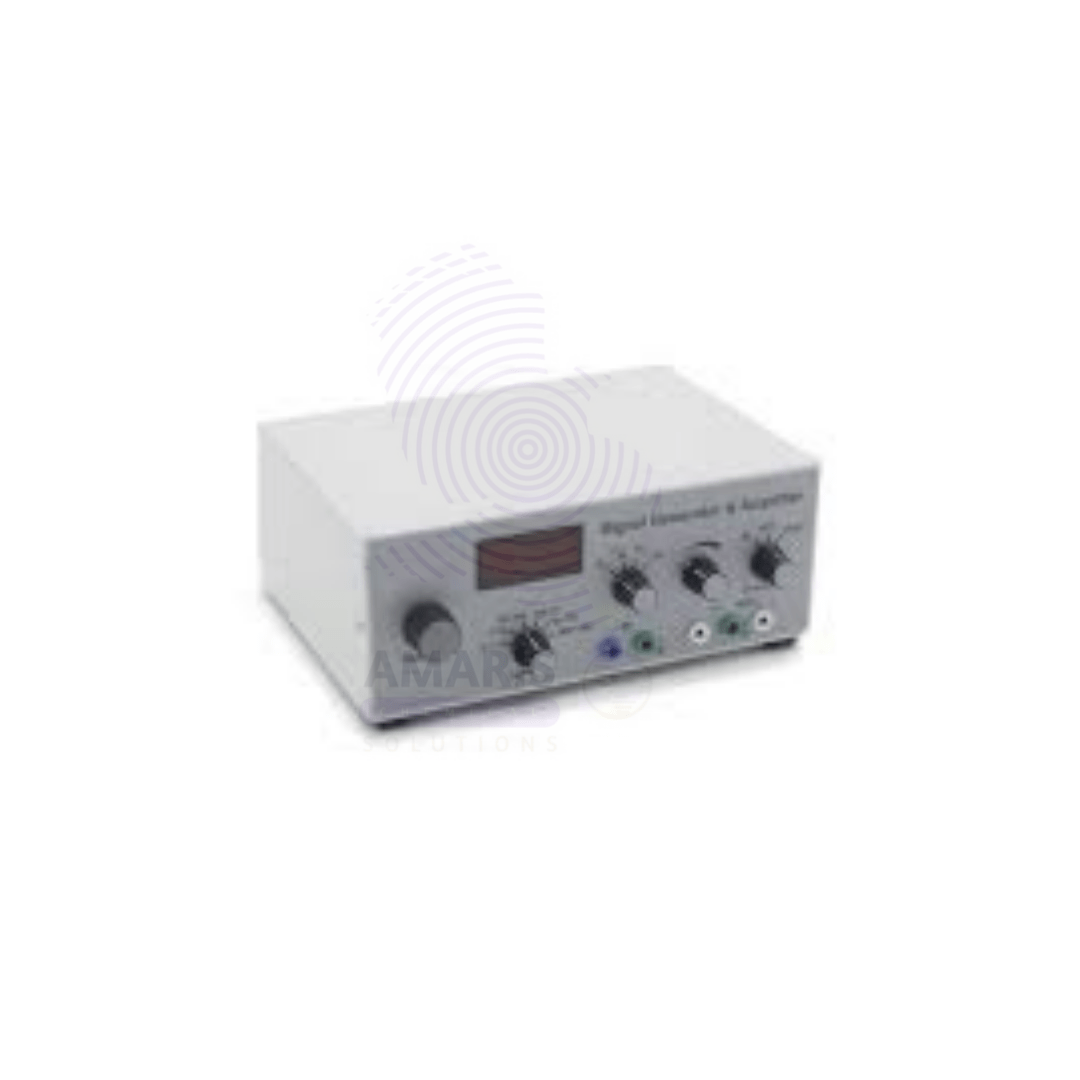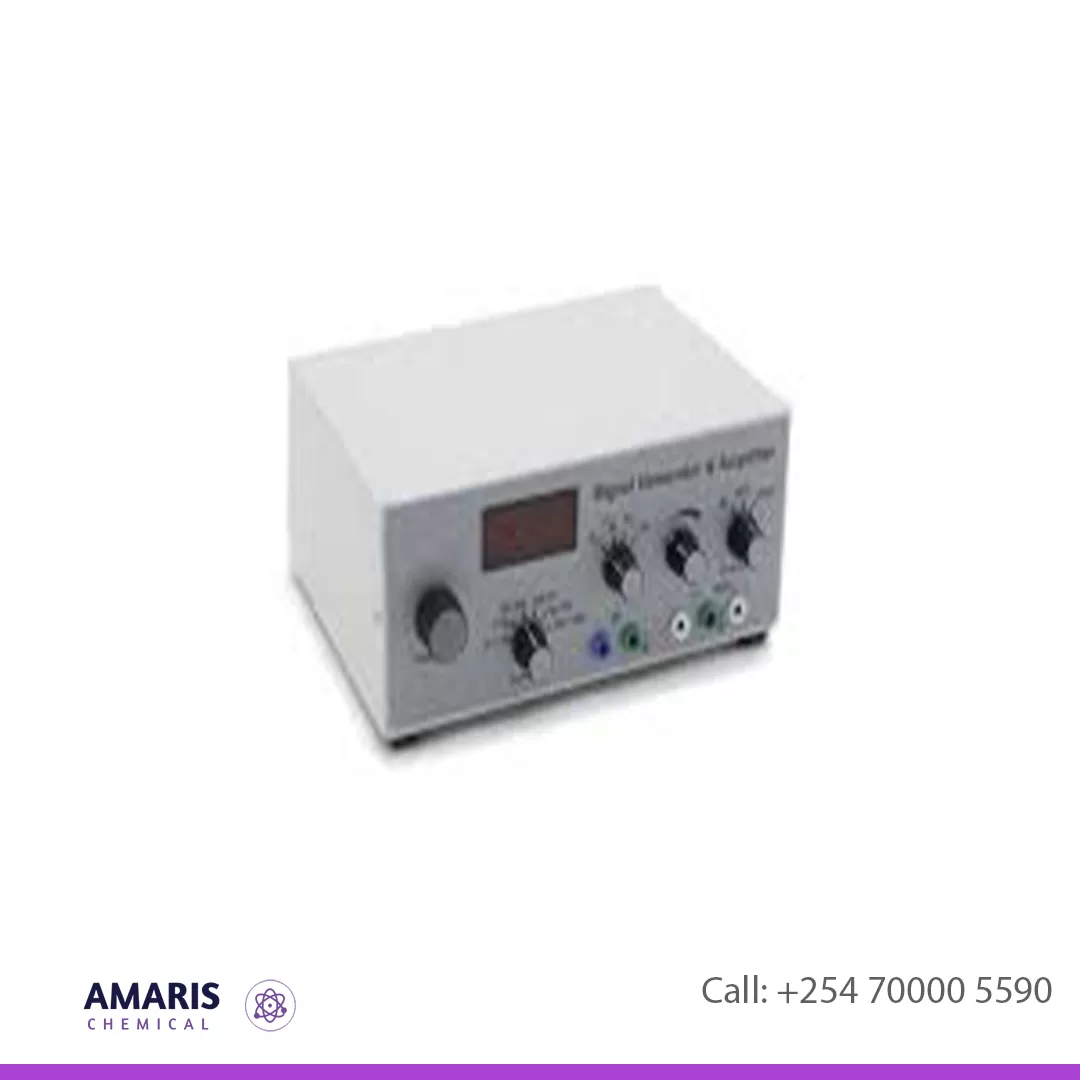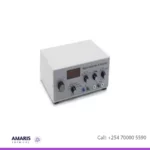“Bernoulli Tube Apparatus” has been added to your cart. View cart

Fractionating Column
$0.01

Galvanometer Zero Centre
$6,500.00 Original price was: $6,500.00.$6,400.00Current price is: $6,400.00.
Frequency and Signal Generator
$0.01
Whatsapp Order
Frequency and signal generators are fundamental tools in laboratory settings across various disciplines, including electronics, telecommunications, physics, and engineering. These instruments are used to generate precise electrical waveforms, such as sine waves, square waves, triangular waves, and arbitrary waveforms, at specific frequencies and amplitudes.
SKU:
ACS25912CHEM0
Category: LABORATORY EQUIPMENT & APPARATUS
Description
Uses of Frequency and Signal Generator
- Testing and Calibration:
- Electronic Devices: Frequency and signal generators are used to test and calibrate electronic devices such as amplifiers, filters, oscillators, and sensors.
- Circuit Prototyping: Engineers use generators to test circuit prototypes and verify their performance under different signal conditions.
- Radio Frequency (RF) Systems: In RF laboratories, generators are essential for testing and calibrating components and systems used in wireless communication, radar, and satellite communication.
- Characterization and Analysis:
- Frequency Response Analysis: Generators are used in conjunction with oscilloscopes and spectrum analyzers to characterize the frequency response of circuits, filters, and systems.
- Noise Analysis: They help analyze the noise characteristics of electronic components and systems, crucial in fields like telecommunications and sensor design.
- Signal Integrity Testing: Engineers use generators to assess the signal integrity of high-speed digital communication links and circuits.
- Education and Training:
- Electronics Labs: In educational institutions, frequency and signal generators are used to demonstrate concepts such as waveforms, modulation techniques, and filter behavior in electronics labs.
- Training Workshops: They are employed in workshops and training sessions for students and professionals to gain practical experience in signal generation and measurement techniques.
- Communication Systems:
- Modulation Testing: Generators are used to simulate modulation signals (e.g., amplitude modulation, frequency modulation) for testing communication systems’ receivers and demodulators.
- Baseband and RF Signal Generation: They generate baseband and RF signals for testing transmitters, receivers, and transceivers in telecommunications and wireless communication systems.
- Research and Development:
- Experimental Setups: Researchers use generators to create controlled signal environments for conducting experiments in areas such as physics, materials science, and biotechnology.
- Component Characterization: They help characterize the behavior of electronic components, such as diodes, transistors, and integrated circuits, under various signal conditions.
- Signal Conditioning and Simulation:
- Control Systems: Generators are used in control systems laboratories to simulate sensor signals, actuator commands, and disturbances for testing and tuning control algorithms.
- Power Electronics: In power electronics labs, they simulate various waveforms to test and validate power converters, inverters, and motor drives.
Reviews (0)
Be the first to review “Frequency and Signal Generator” Cancel reply
Related products
Atomic Model Set
$0.01
A lab atomic model set is a collection of physical models and materials designed to represent the structure of atoms and molecules. It is commonly used in educational and scientific laboratory settings to visually demonstrate the arrangement of protons, neutrons, and electrons within an atom, as well as the bonding patterns between atoms in molecules. These sets typically include colored balls of various sizes representing different types of atoms, as well as connectors or magnets to simulate chemical bonds between them. The purpose of these sets is to help students and researchers better understand the principles of atomic and molecular structure in a tangible and interactive way.
Balance Bathroom Scale
$0.01
balance spring
$0.01
bell in vacuum
$0.01
A "bell in vacuum" apparatus is a scientific setup used to demonstrate the effects of reduced air pressure (vacuum) on sound transmission. It typically consists of a bell or sound-producing object enclosed within a sealed chamber from which air has been removed, creating a low-pressure environment. This apparatus is designed to illustrate how sound travels differently in a vacuum compared to in normal atmospheric conditions, highlighting the role of air molecules in sound propagation.
Bell Jar with knob
$0.01
The best definition of a bell jar apparatus is a scientific instrument used in laboratories to create a controlled environment for various experimental purposes, such as studying the behavior of gases, conducting vacuum experiments, or demonstrating principles of physics and chemistry. It consists of a glass or transparent plastic container shaped like a bell, which can be sealed to create a vacuum chamber. The apparatus allows researchers to manipulate and observe the interactions of substances or objects within the vacuum or controlled atmosphere, often enabling investigations that wouldn't be possible under standard atmospheric conditions.
Blotting paper
$0.01
Blotting paper is a highly absorbent and thin sheet of paper, typically made from materials like cotton, linen, or other plant fibers. It is designed to quickly absorb excess liquids, such as ink, oil, or moisture, from various surfaces without smudging or smearing the substances. Blotting paper is commonly used to remove excess ink from a freshly written page, absorb oil from the skin without disturbing makeup, or dry wet items. It is often found in office settings, art studios, and cosmetic applications due to its efficient absorption properties.


 Emollients
Emollients Humectants
Humectants UV Filters
UV Filters Surfactants (cosmetic)
Surfactants (cosmetic) Preservatives (cosmetic)
Preservatives (cosmetic) Fragrances and Essential Oils
Fragrances and Essential Oils Antioxidants (cosmetics)
Antioxidants (cosmetics)
 Solvents (lab)
Solvents (lab) Chromatography Chemicals
Chromatography Chemicals Microbiology and Cell Culture Reagents
Microbiology and Cell Culture Reagents Biochemical Reagents
Biochemical Reagents Inorganic and Organic Standards
Inorganic and Organic Standards Spectroscopy Reagents
Spectroscopy Reagents Molecular Biology Reagents
Molecular Biology Reagents
 Precious Metal Extraction Agents
Precious Metal Extraction Agents
 Plasticizers
Plasticizers Polymerization Initiators
Polymerization Initiators Stabilizers
Stabilizers Monomers
Monomers Fillers and Reinforcements
Fillers and Reinforcements Antioxidants (plastics)
Antioxidants (plastics) Colorants (plastic pigments,Dyes)
Colorants (plastic pigments,Dyes)
 Fertilizers
Fertilizers Plant Growth Regulators
Plant Growth Regulators Soil Conditioners
Soil Conditioners Animal Feed Additives
Animal Feed Additives Biostimulants
Biostimulants
 Dough Conditioners
Dough Conditioners Flour Treatments
Flour Treatments Fat Replacers
Fat Replacers Preservatives (baking)
Preservatives (baking)
 Surfactants (cleaning)
Surfactants (cleaning) Builders
Builders Bleaching Agents
Bleaching Agents Enzymes
Enzymes Solvents (cleaning)
Solvents (cleaning) Fragrances
Fragrances Disinfectant
Disinfectant Metal cleaning
Metal cleaning
 Binders/Resins
Binders/Resins Pigments
Pigments Solvents (paint)
Solvents (paint) Additives
Additives Driers
Driers Anti-Corrosion Agents
Anti-Corrosion Agents Specialty Coatings
Specialty Coatings Functional Coatings
Functional Coatings Application-Specific Coatings
Application-Specific Coatings
 Sealants and Adhesives
Sealants and Adhesives
 Biodegradable Surfactants
Biodegradable Surfactants Bio-based Solvents
Bio-based Solvents Renewable Polymers
Renewable Polymers Carbon Capture Chemicals
Carbon Capture Chemicals Wastewater Treatment Chemicals
Wastewater Treatment Chemicals
 Preservatives (food)
Preservatives (food) Flavor Enhancers
Flavor Enhancers Acidulants
Acidulants Sweeteners
Sweeteners Emulsifiers
Emulsifiers Antioxidants (food)
Antioxidants (food) Colorants (food)
Colorants (food) Nutrient Supplements
Nutrient Supplements Nutraceutical Ingredients
Nutraceutical Ingredients
 Fresh Herbs
Fresh Herbs Whole Spices
Whole Spices Ground Spices
Ground Spices Spice Blends
Spice Blends
 Surfactants(oil)
Surfactants(oil)
 Antibiotics
Antibiotics Active Pharmaceutical Ingredients
Active Pharmaceutical Ingredients Excipients
Excipients Vaccine Adjuvants
Vaccine Adjuvants Nutraceutical Ingredients
Nutraceutical Ingredients Solvents (pharmaceutical)
Solvents (pharmaceutical)
 Automotive chemicals
Automotive chemicals Pyrotechnic Chemicals
Pyrotechnic Chemicals


 Vulcanizing Agents
Vulcanizing Agents Accelerators & Retarders
Accelerators & Retarders Antidegradants
Antidegradants Reinforcing Agents
Reinforcing Agents Plasticizers & Softeners
Plasticizers & Softeners Fillers & Extenders
Fillers & Extenders Blowing Agents
Blowing Agents Adhesion Promoters
Adhesion Promoters

























Reviews
There are no reviews yet.